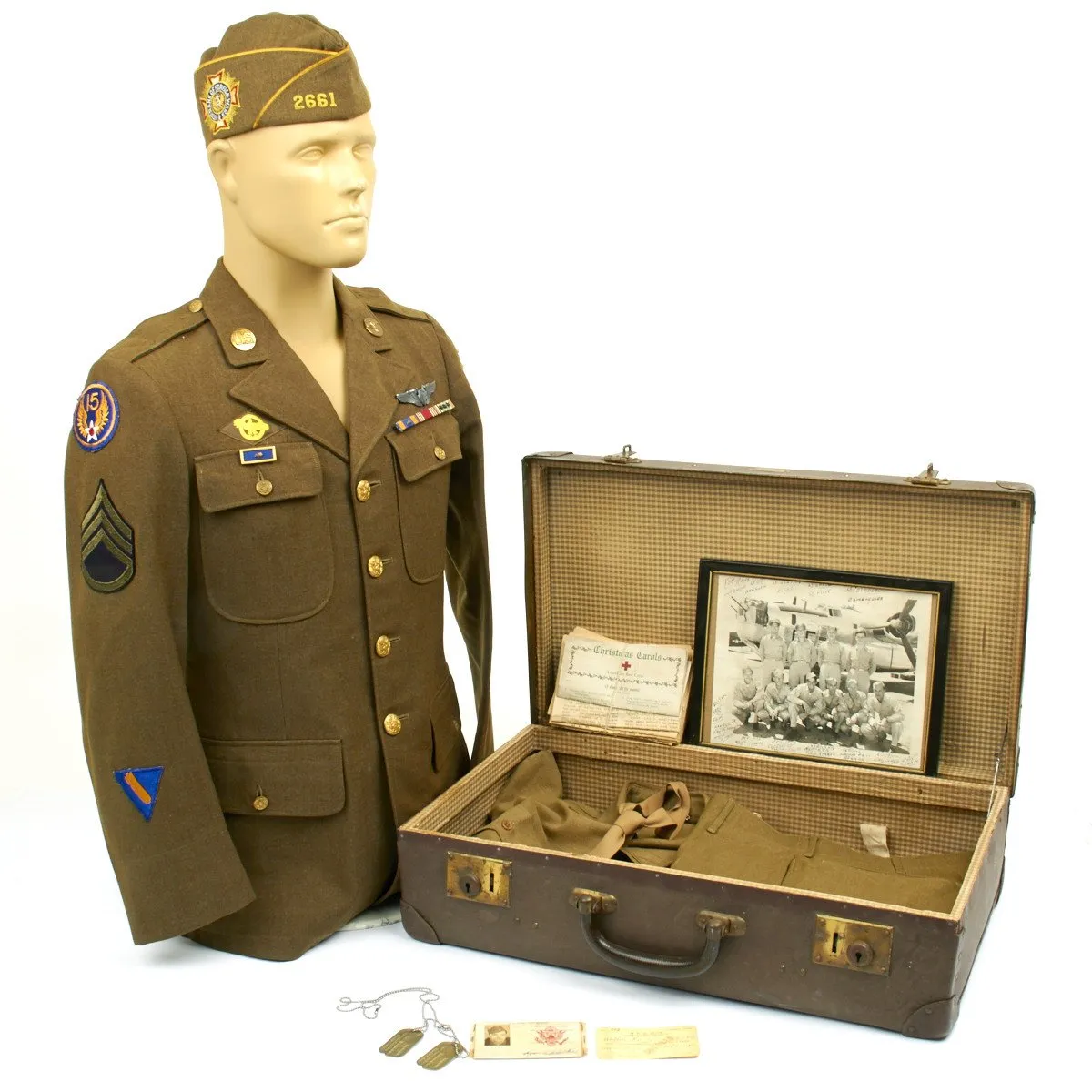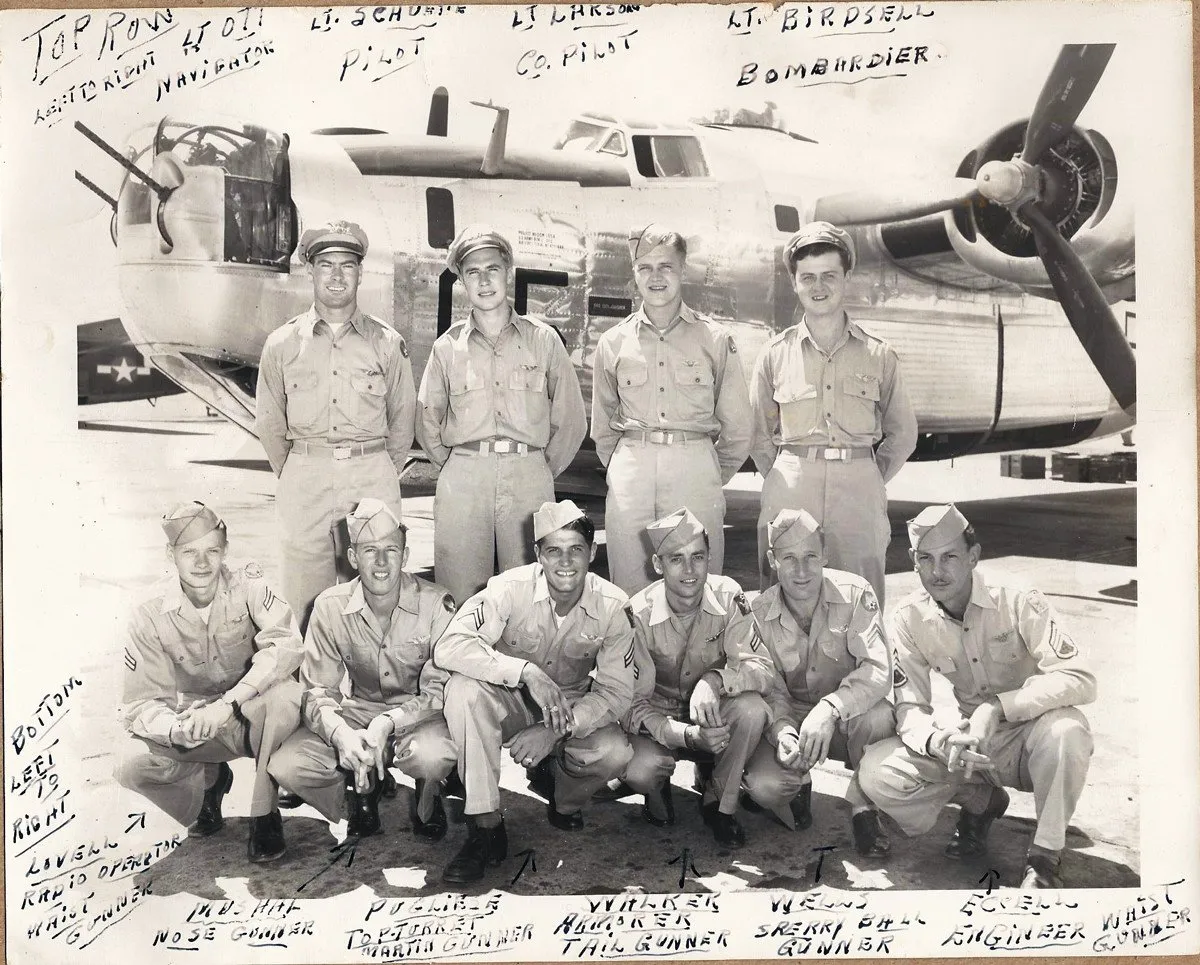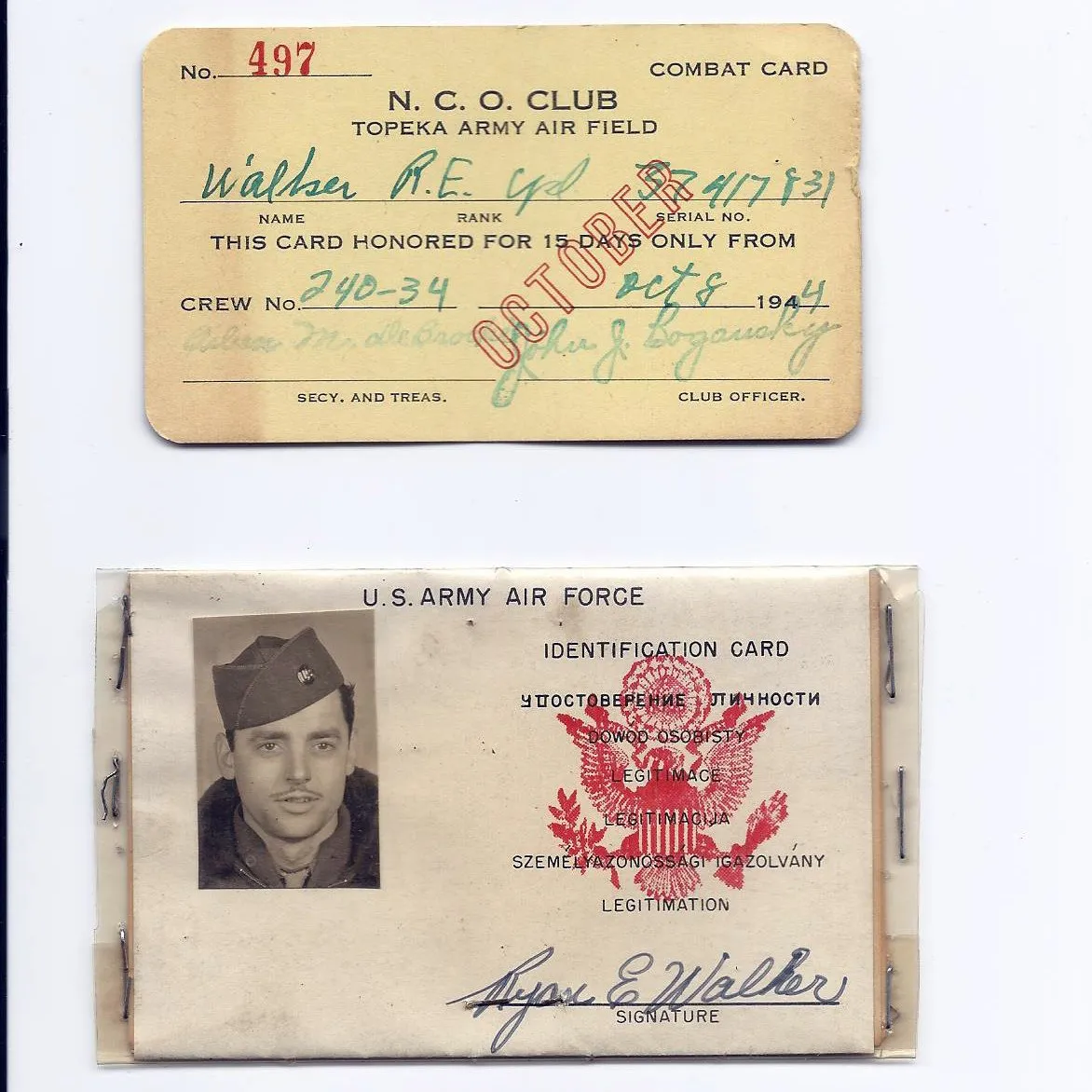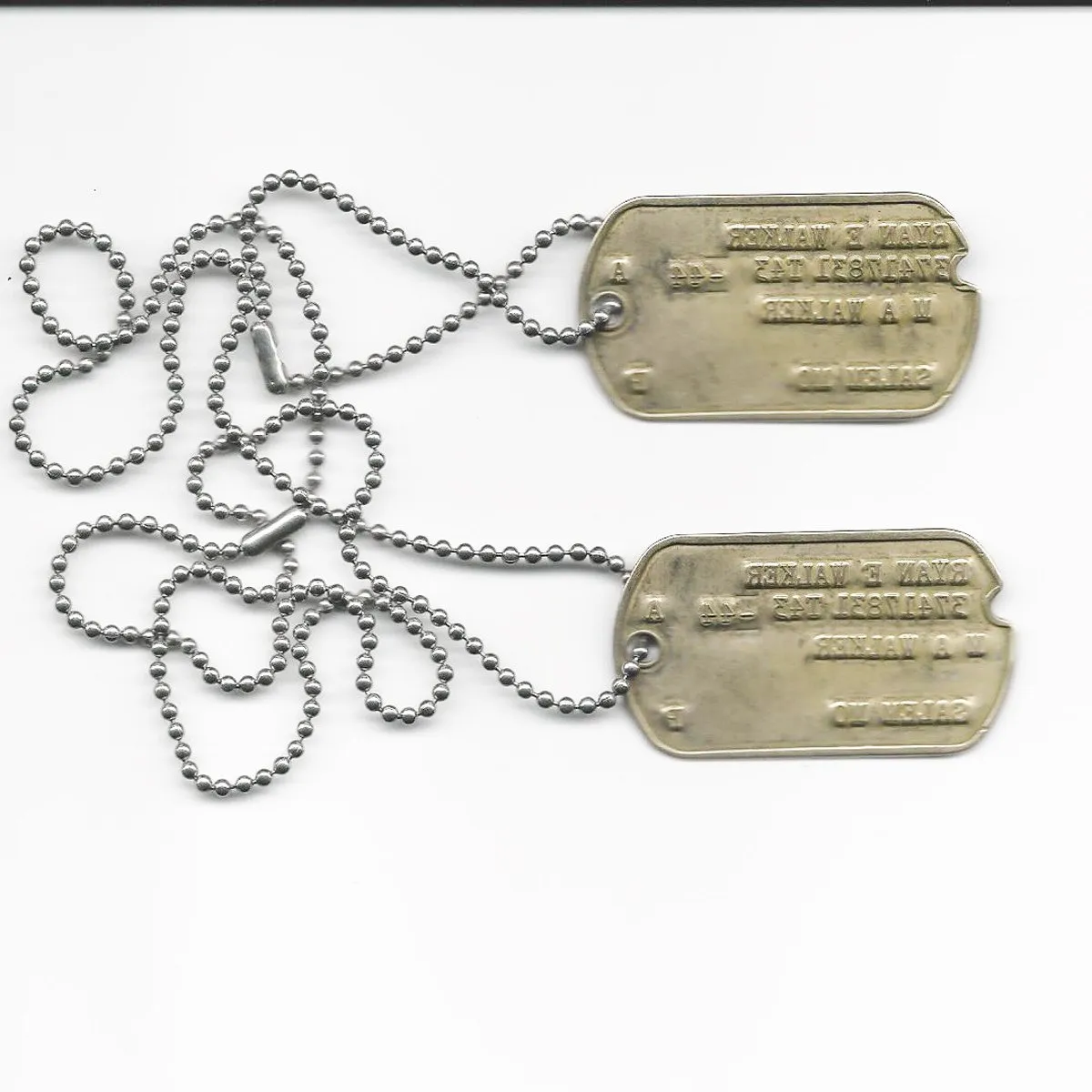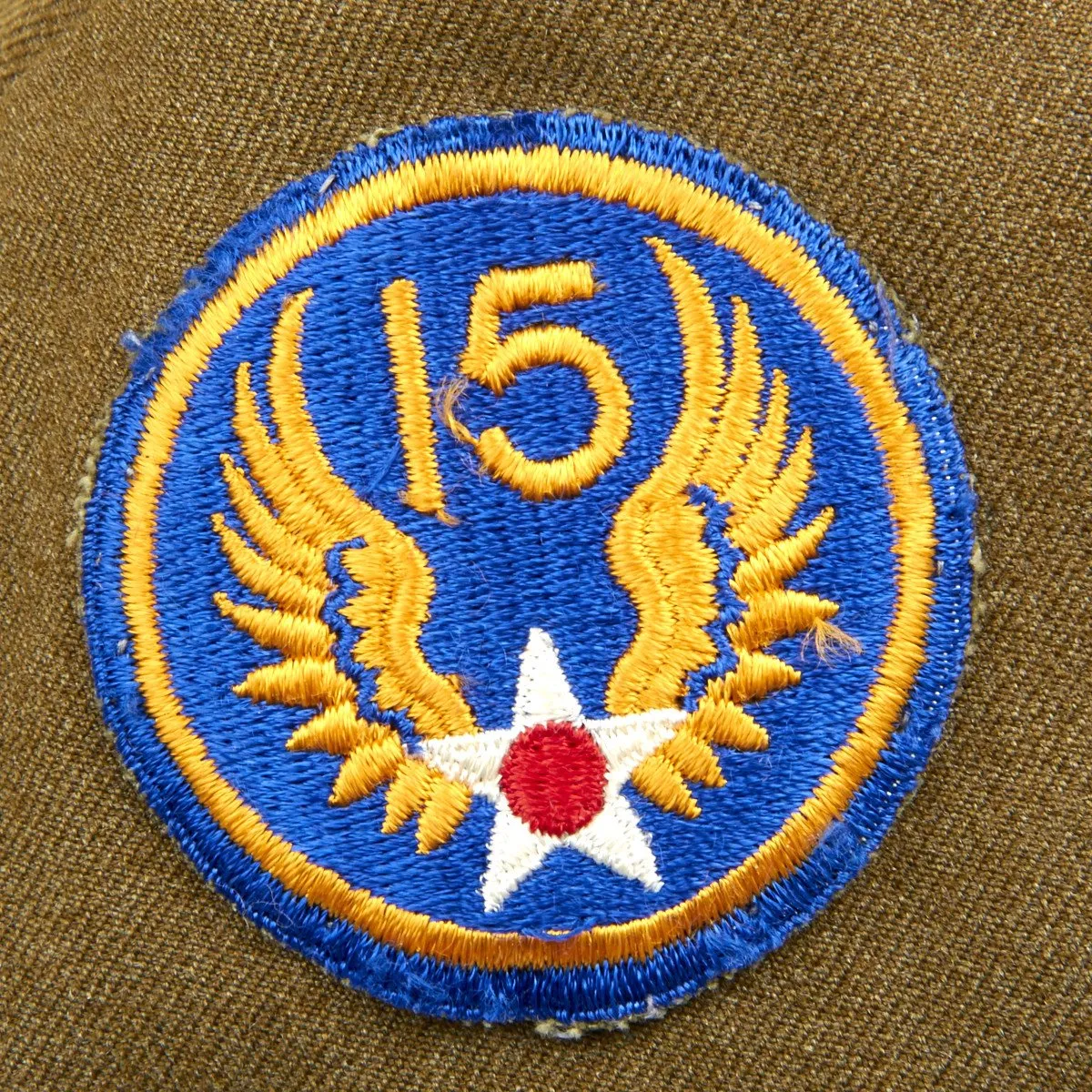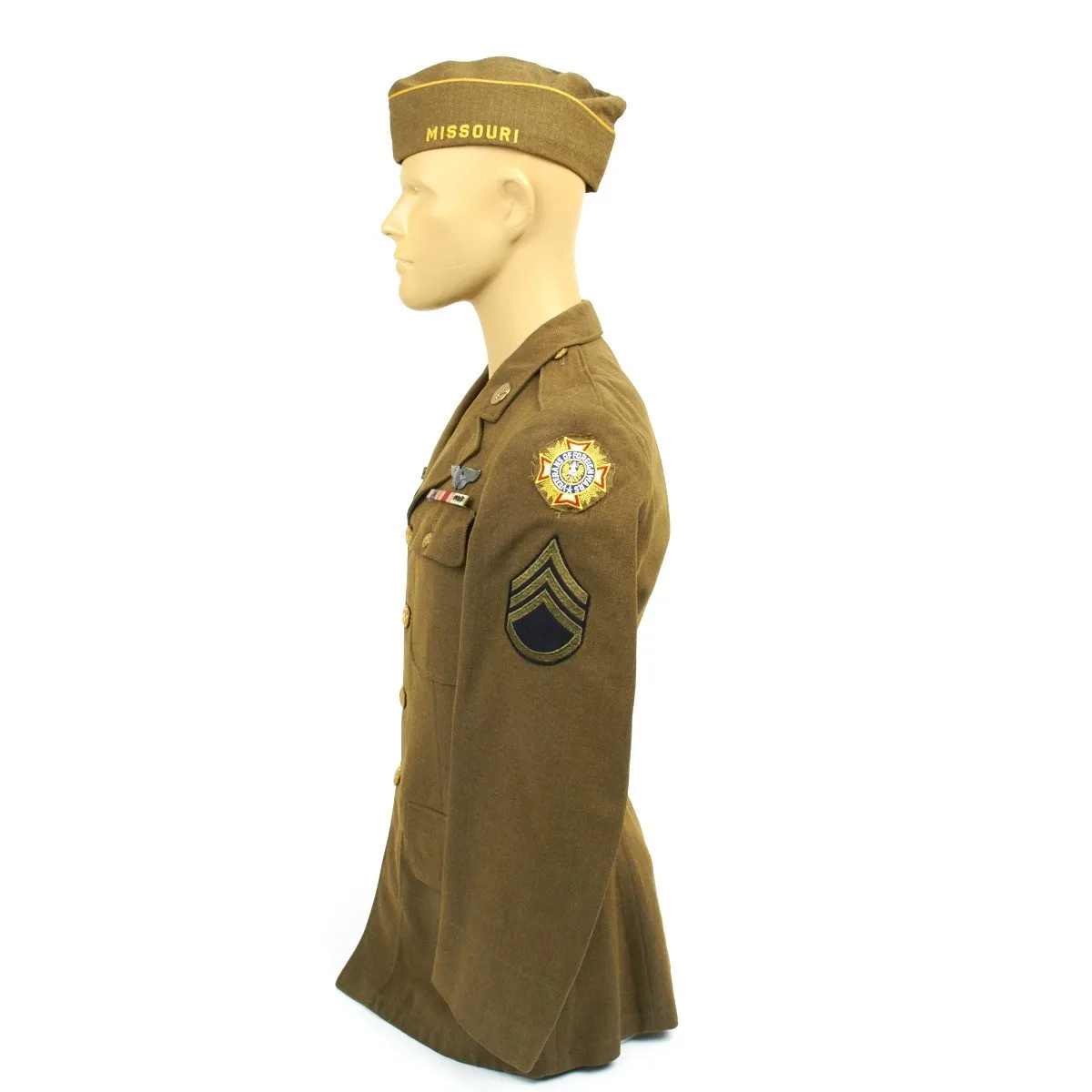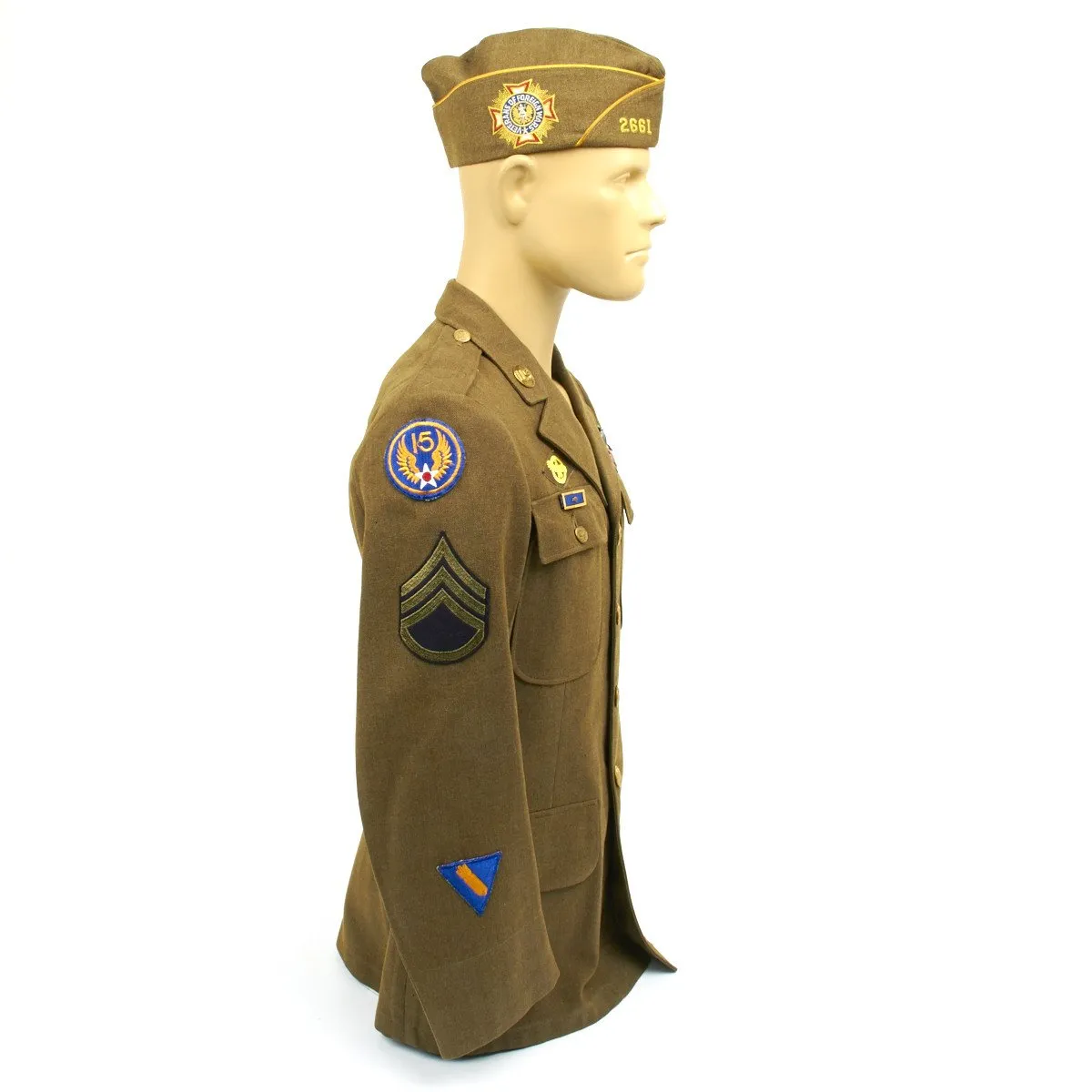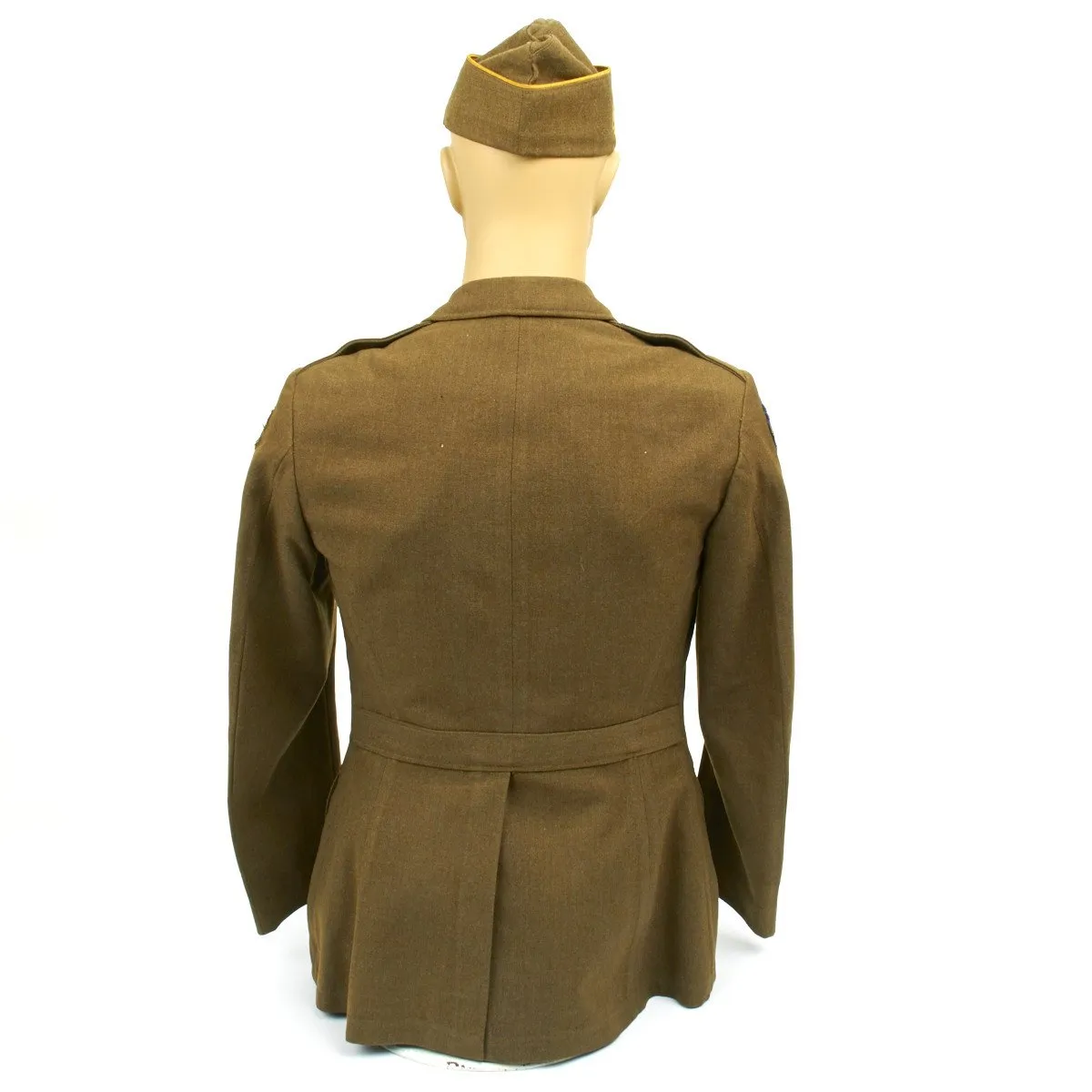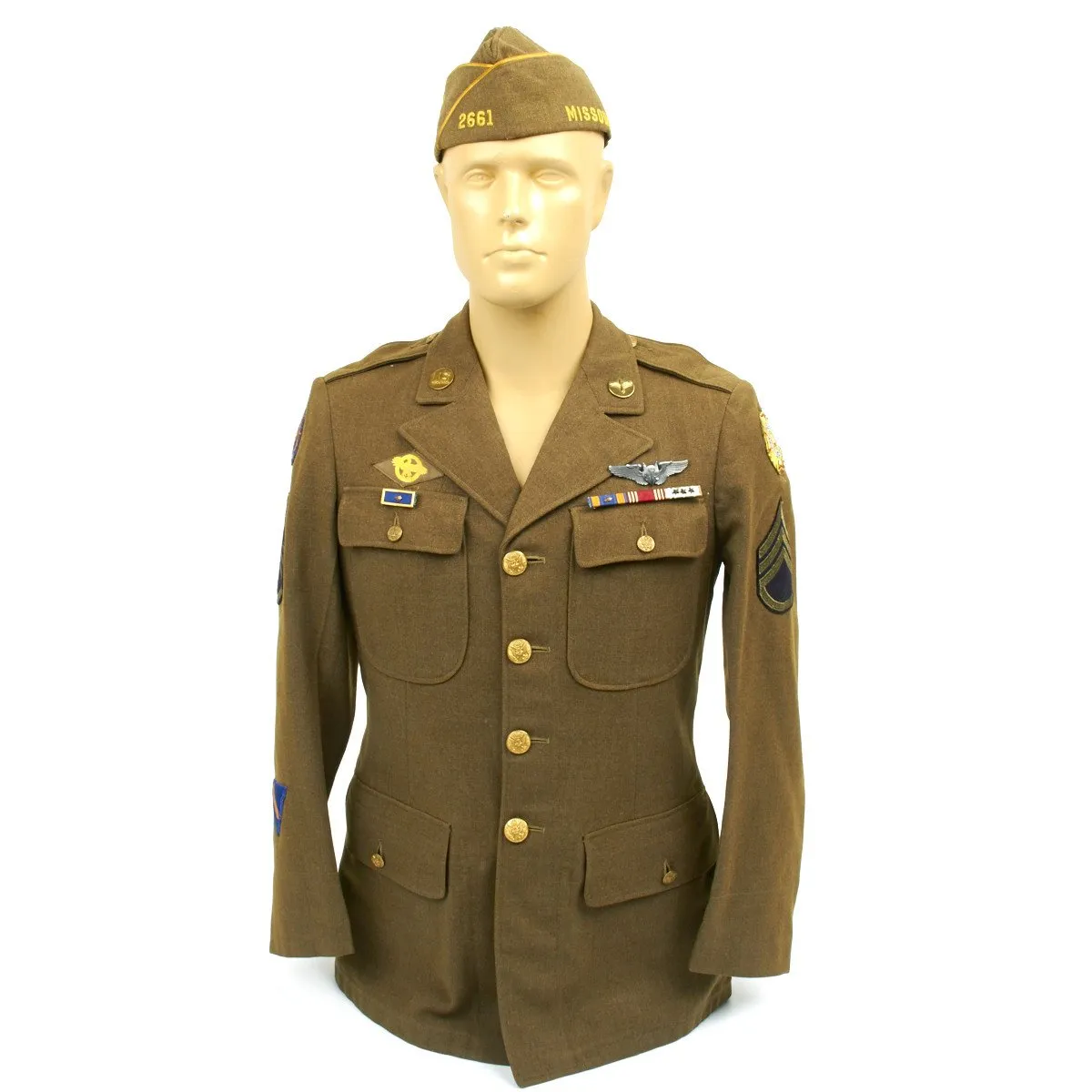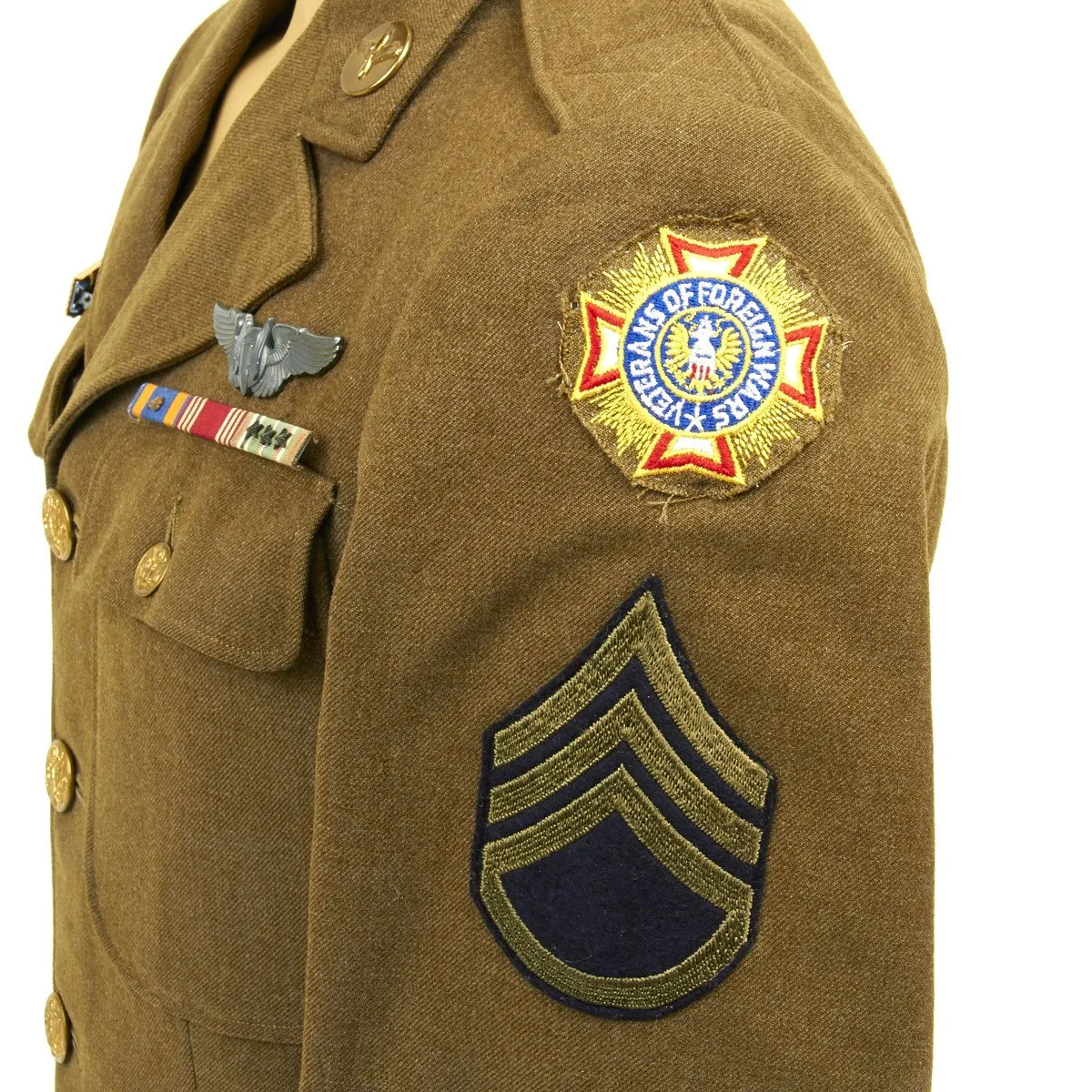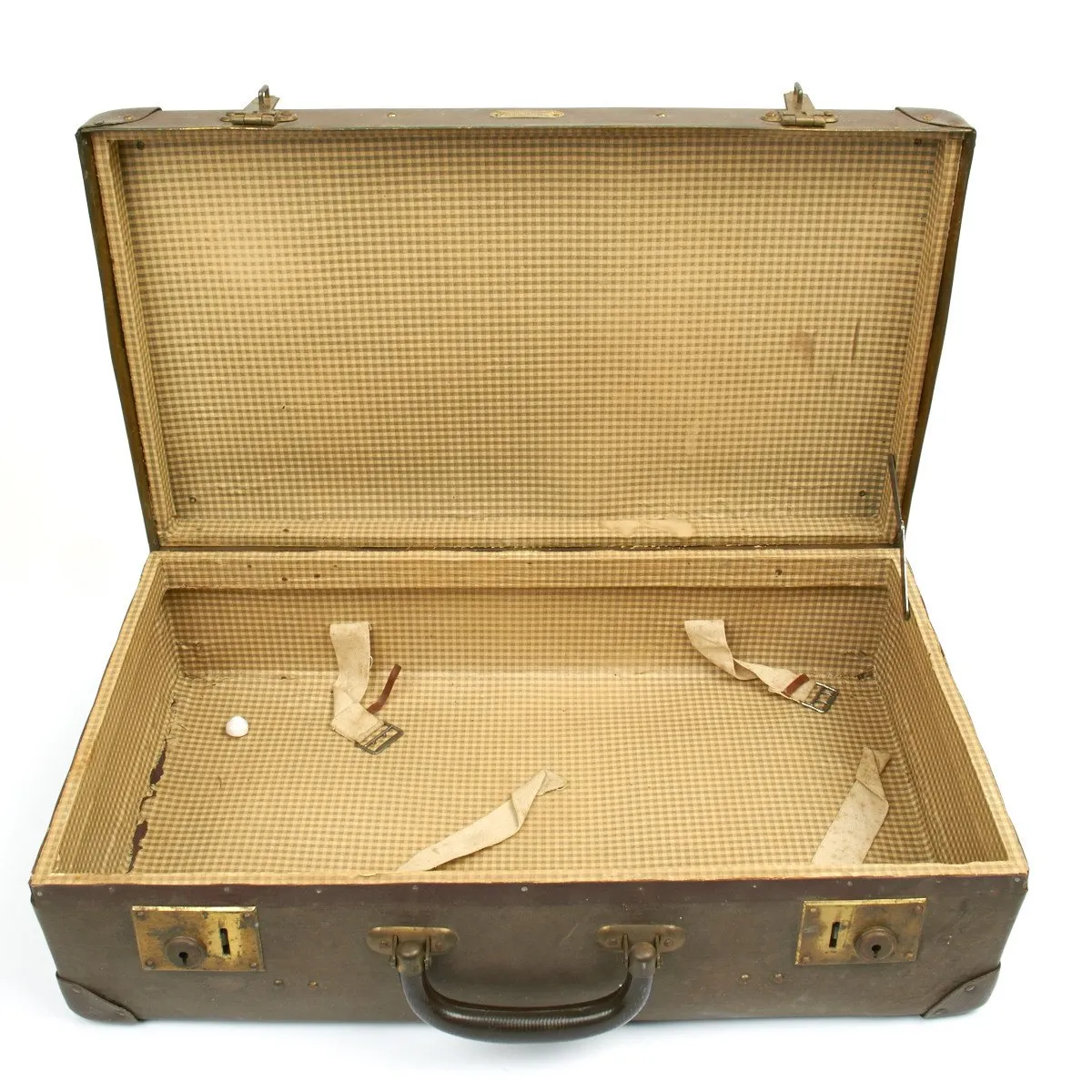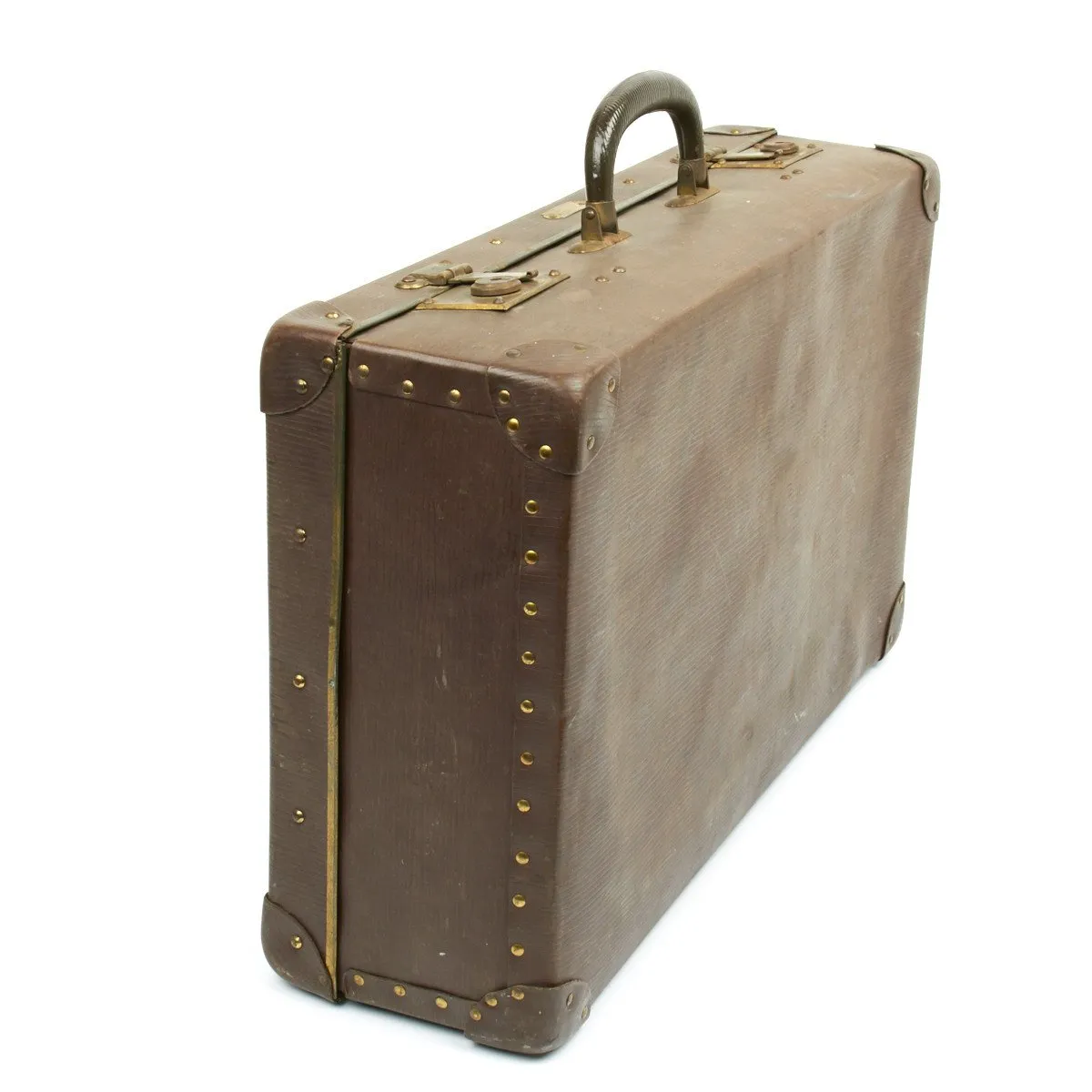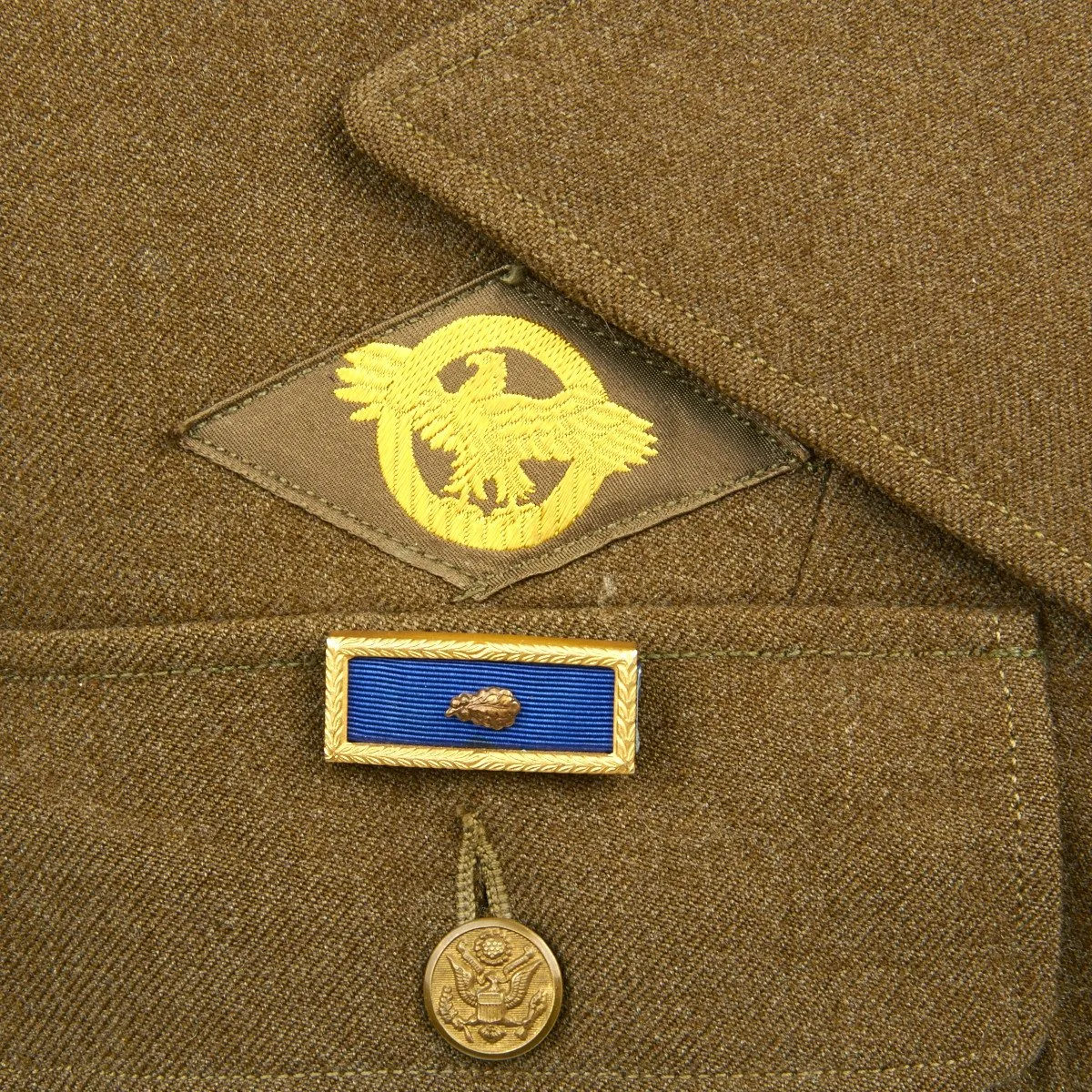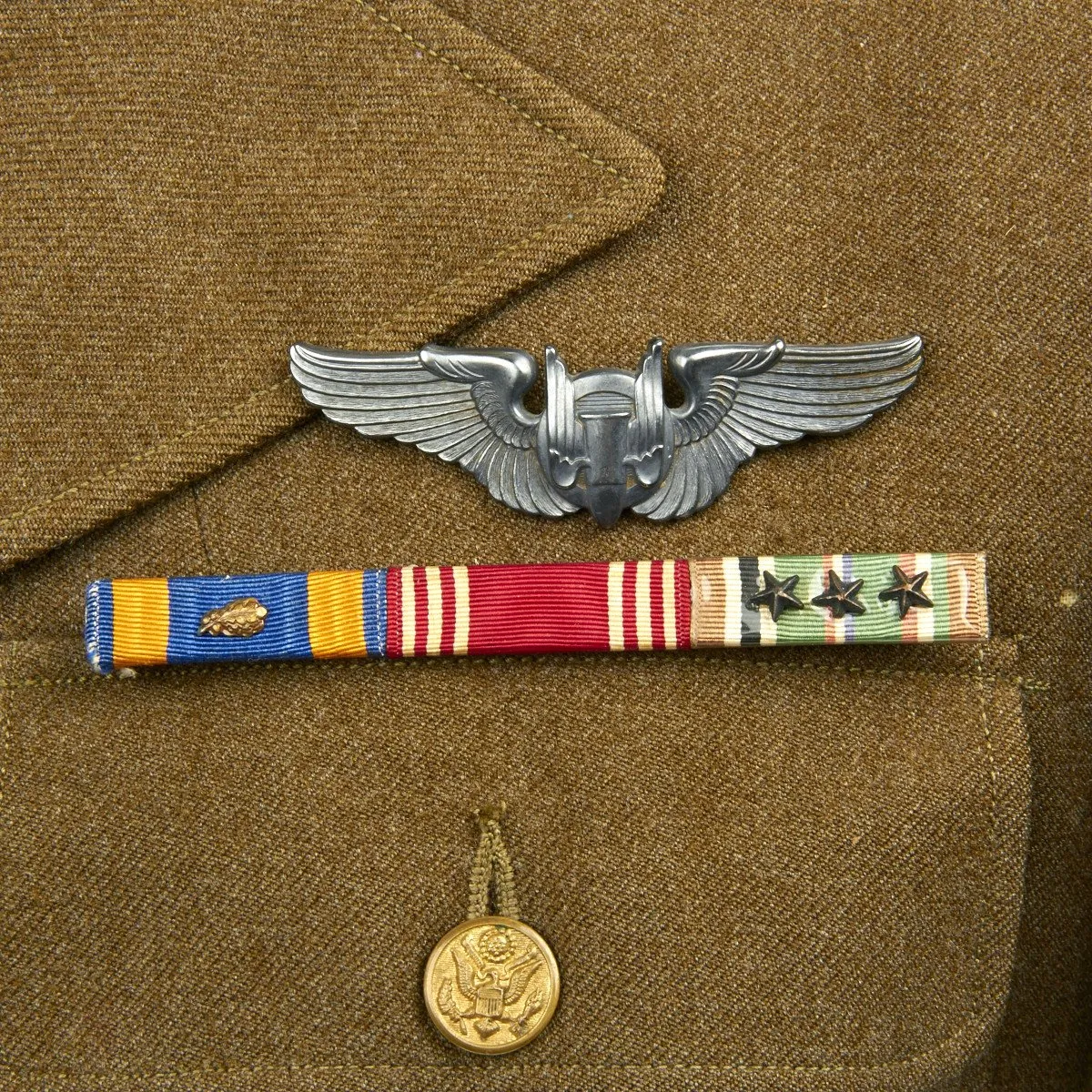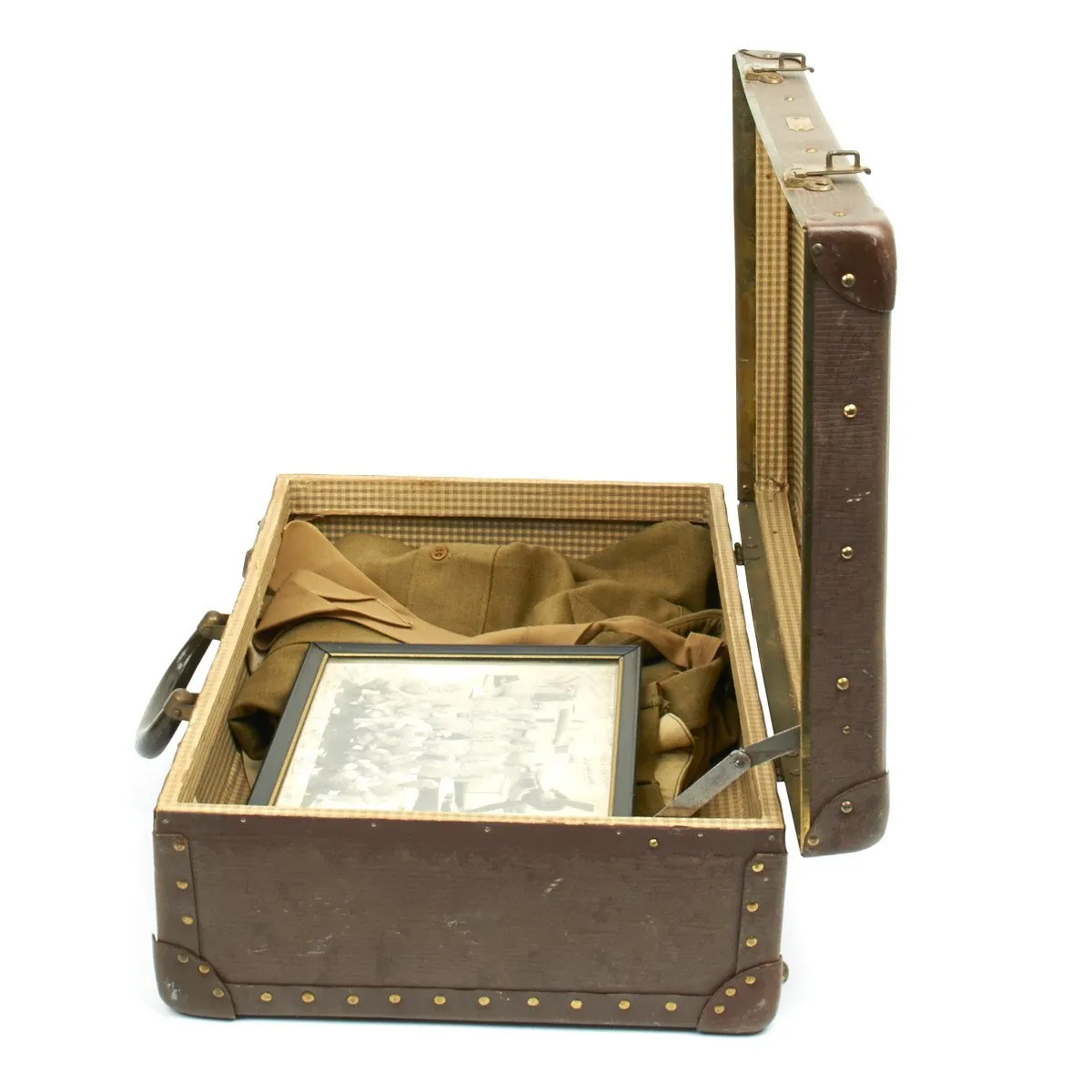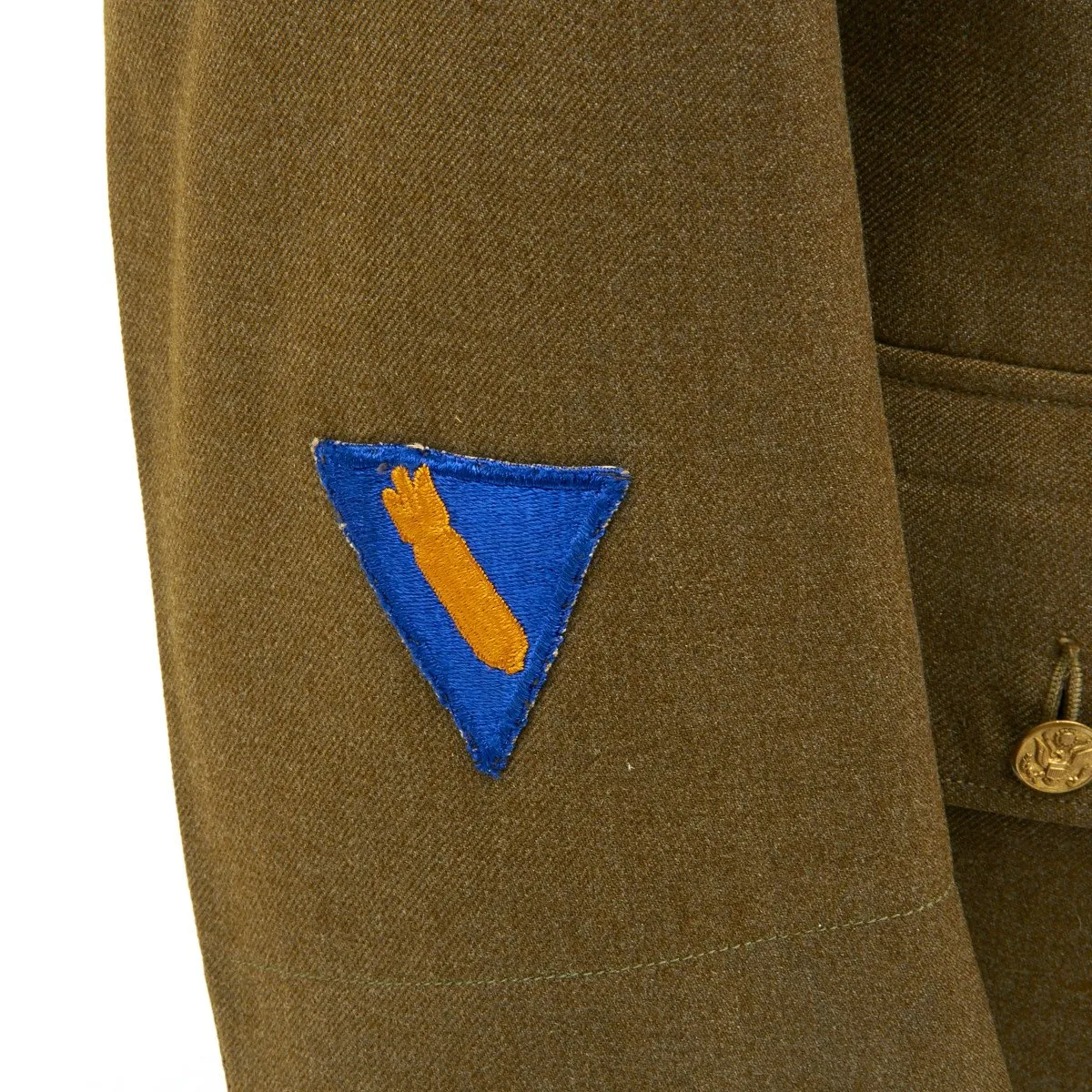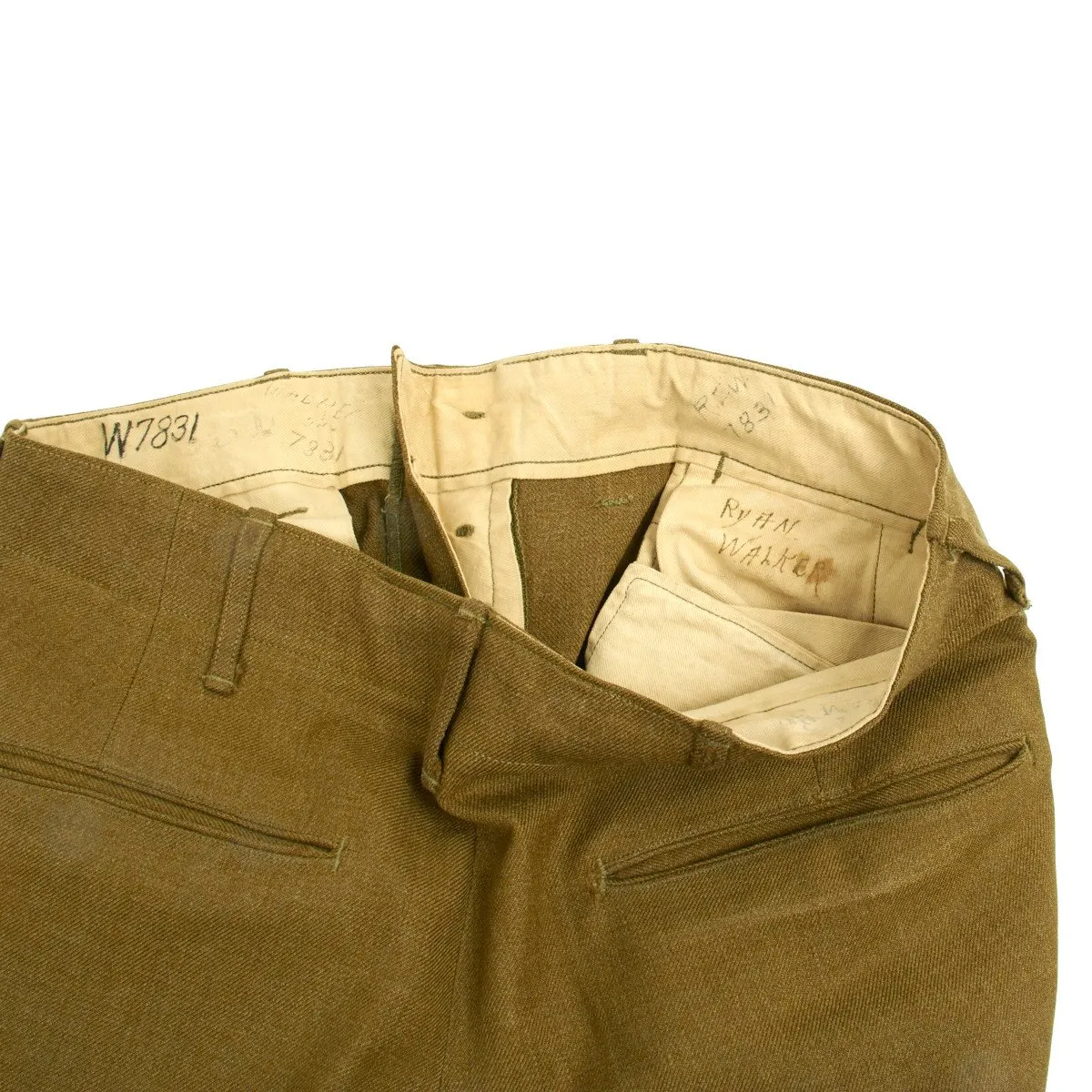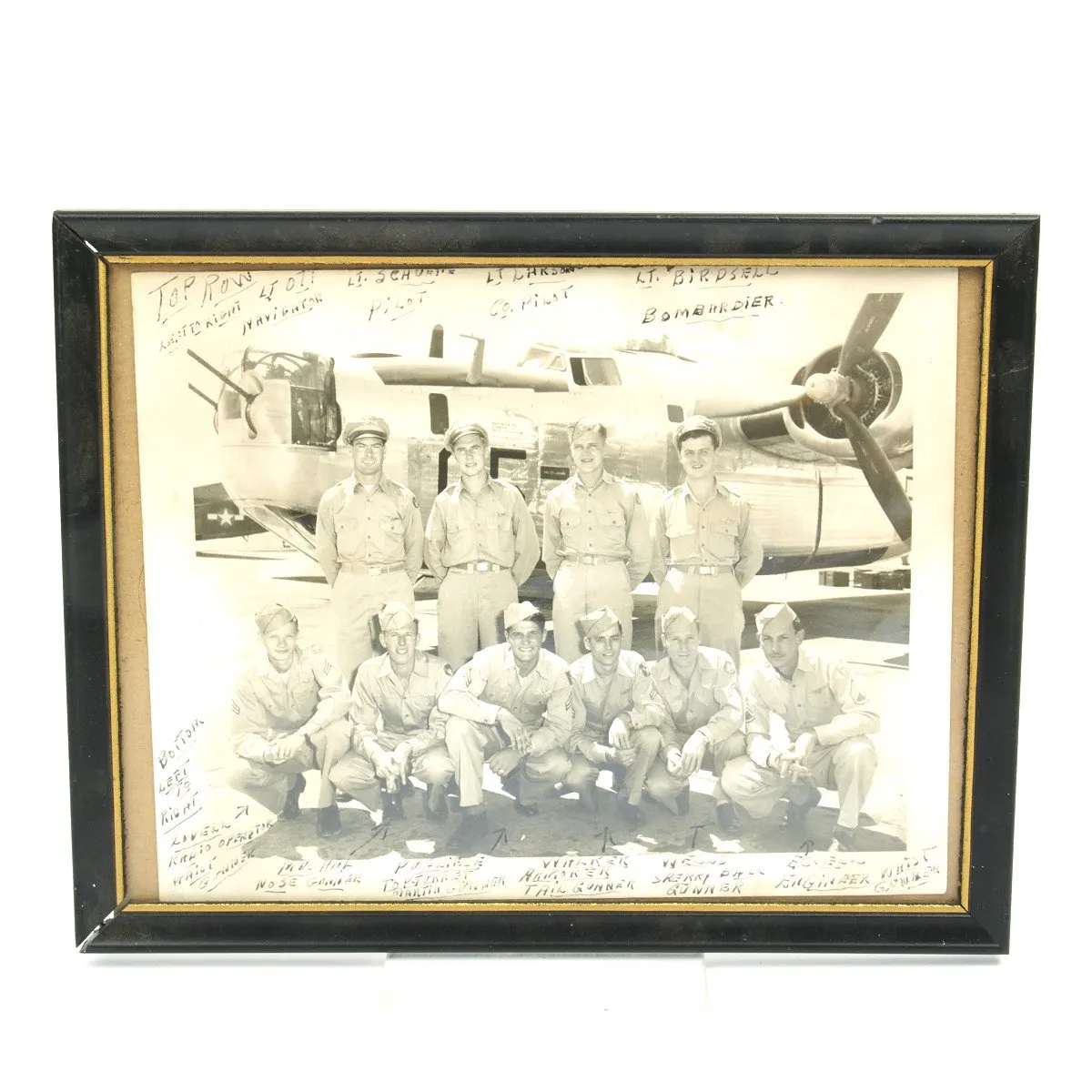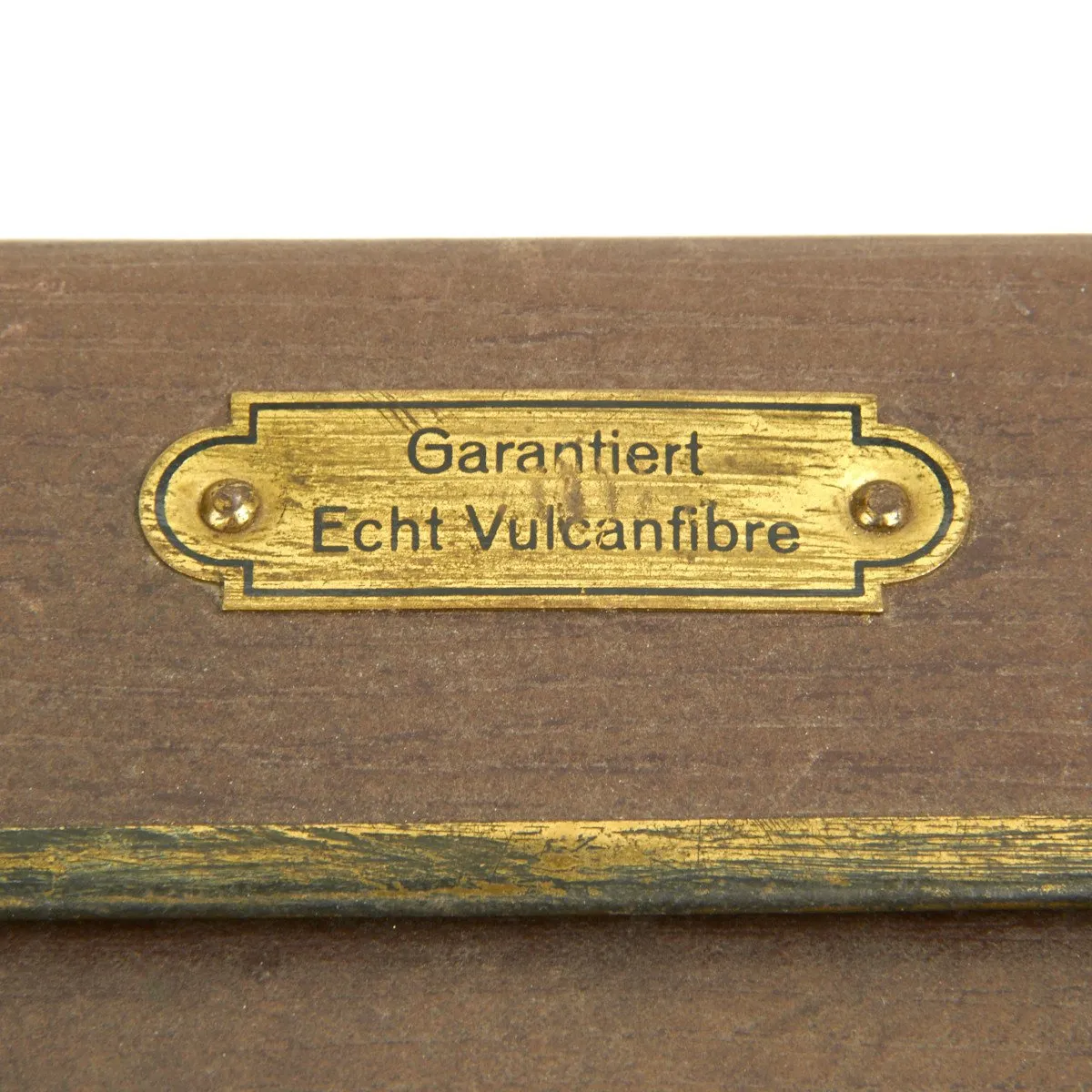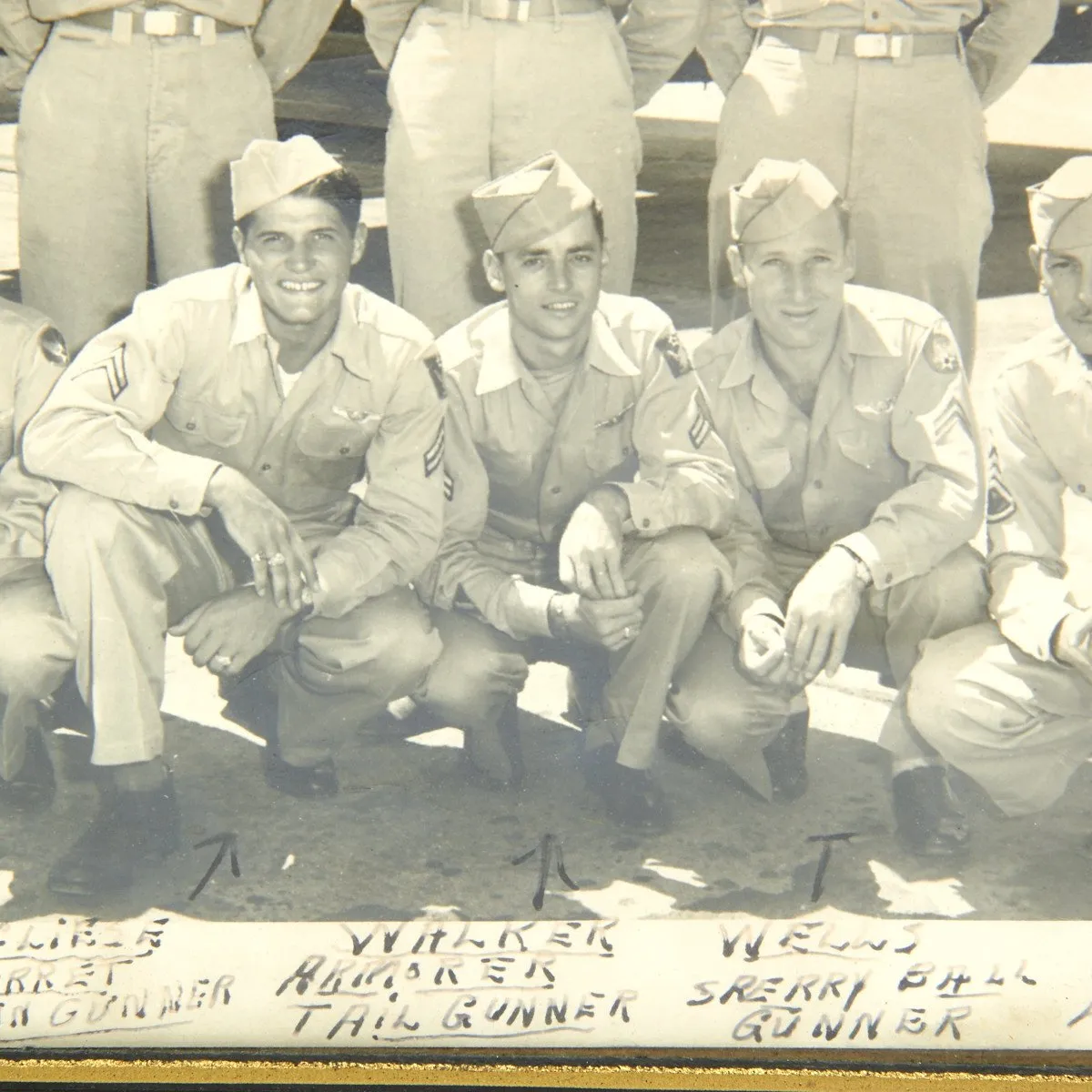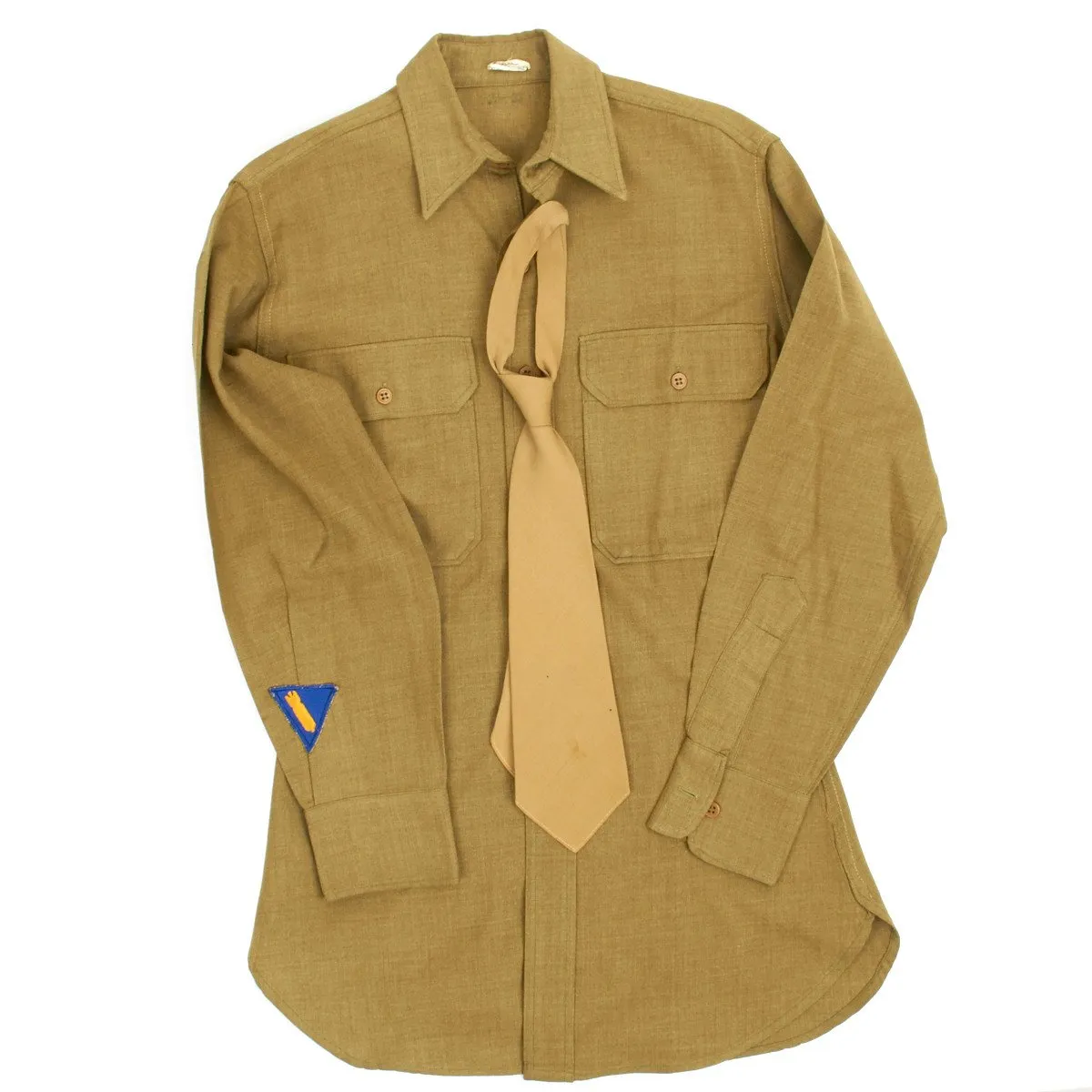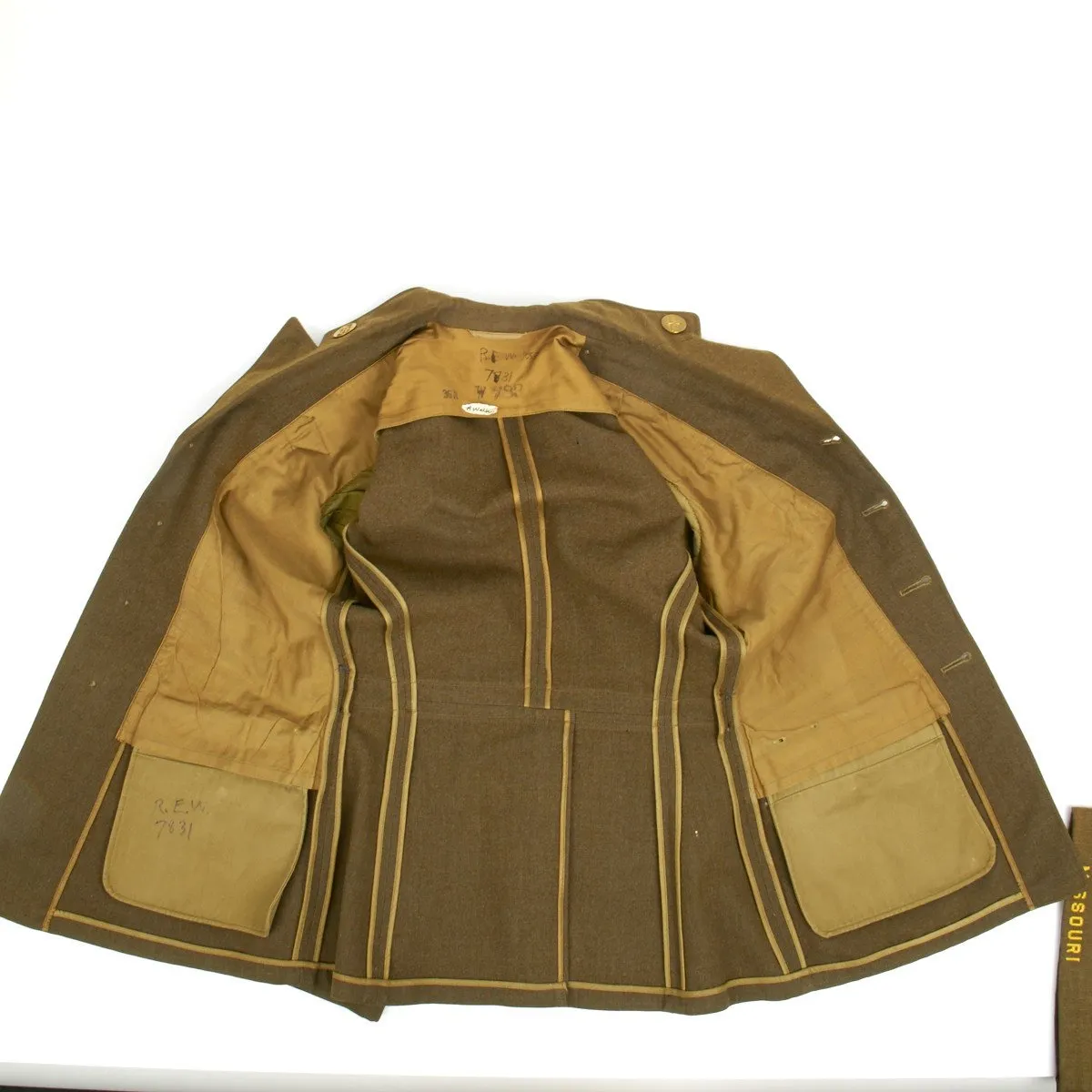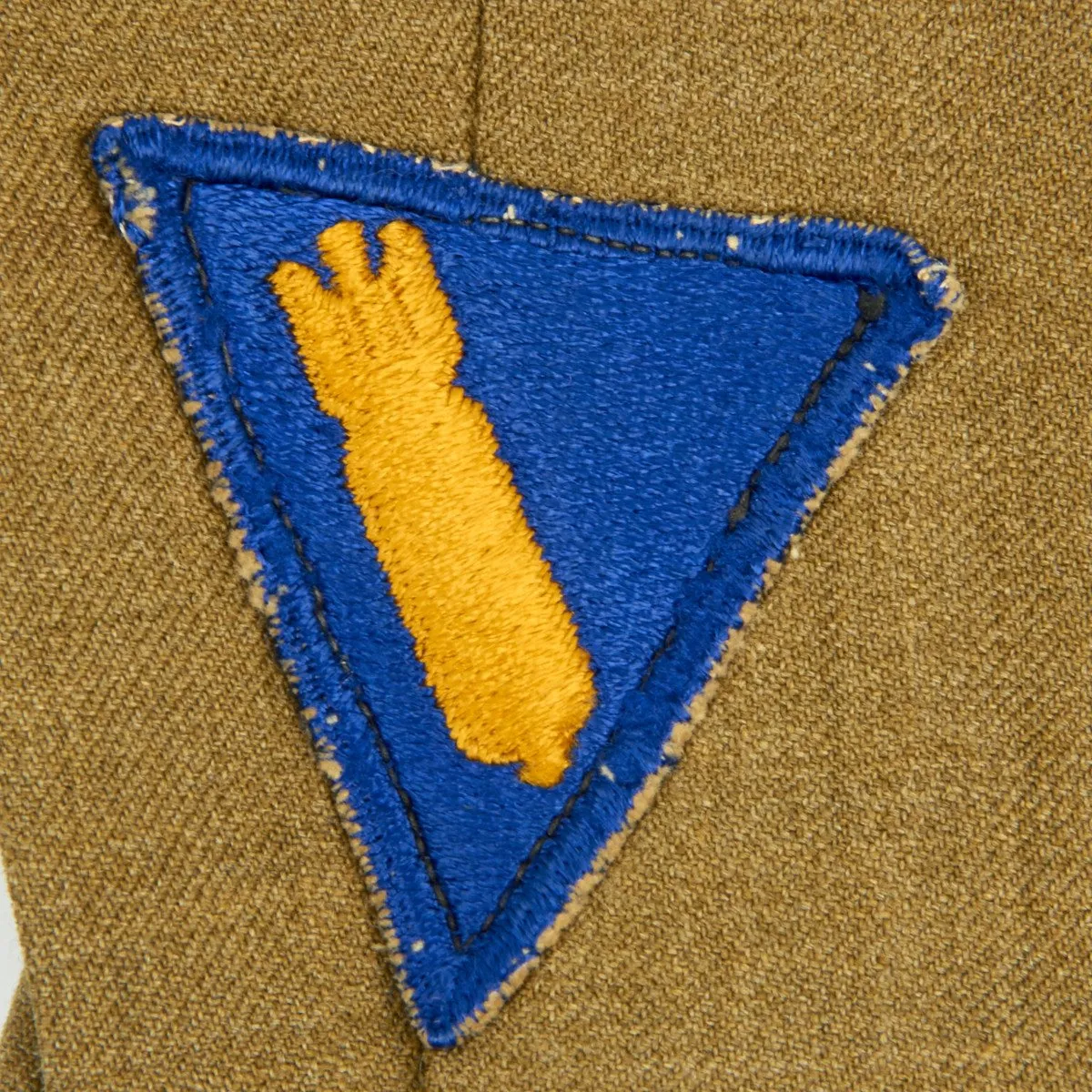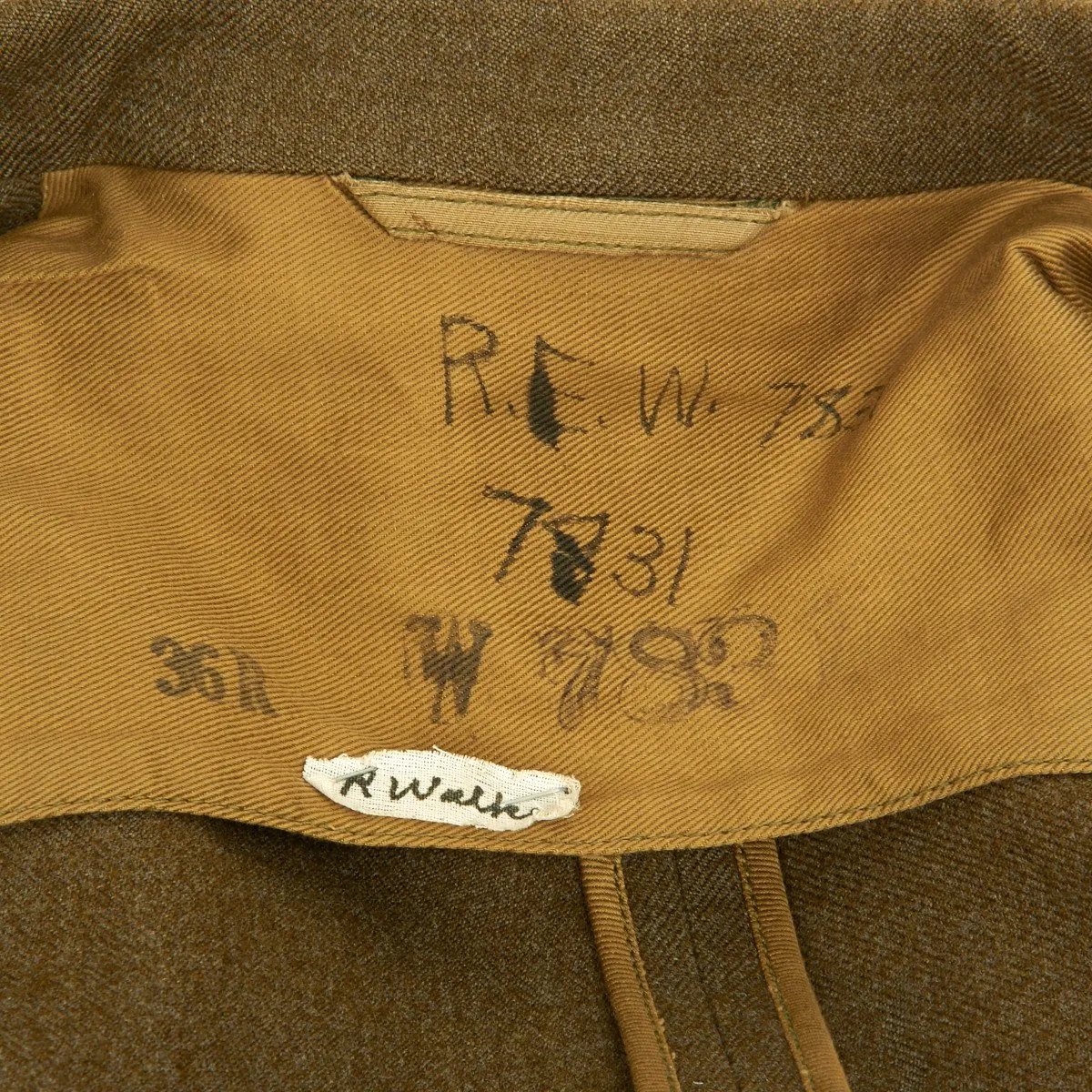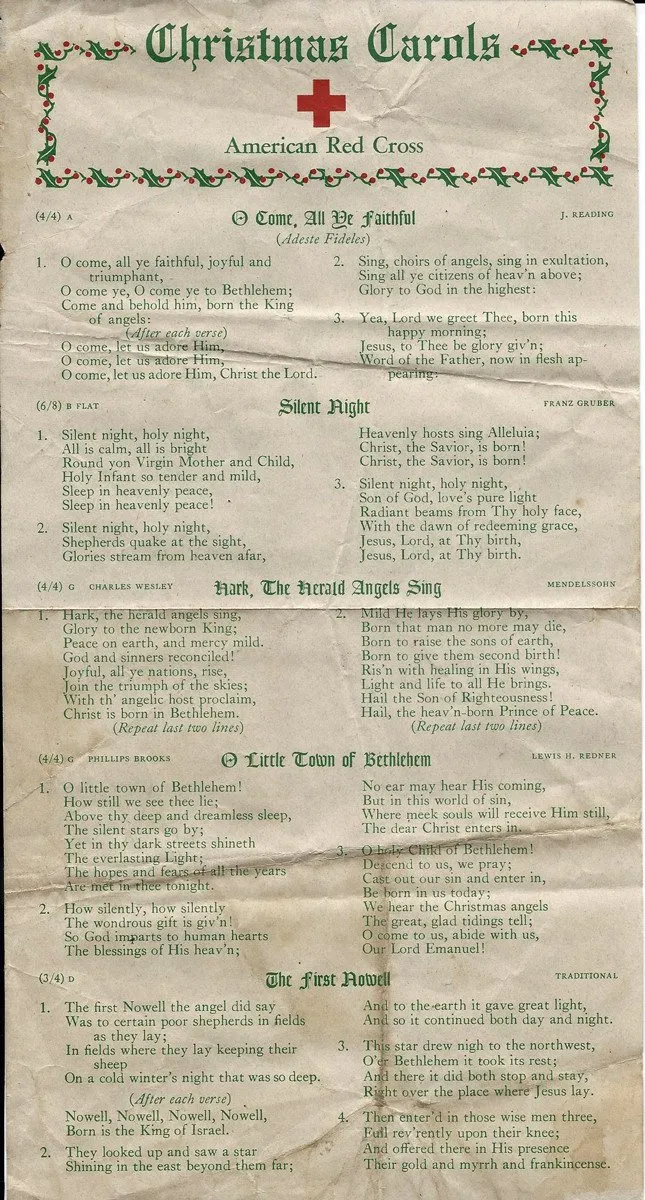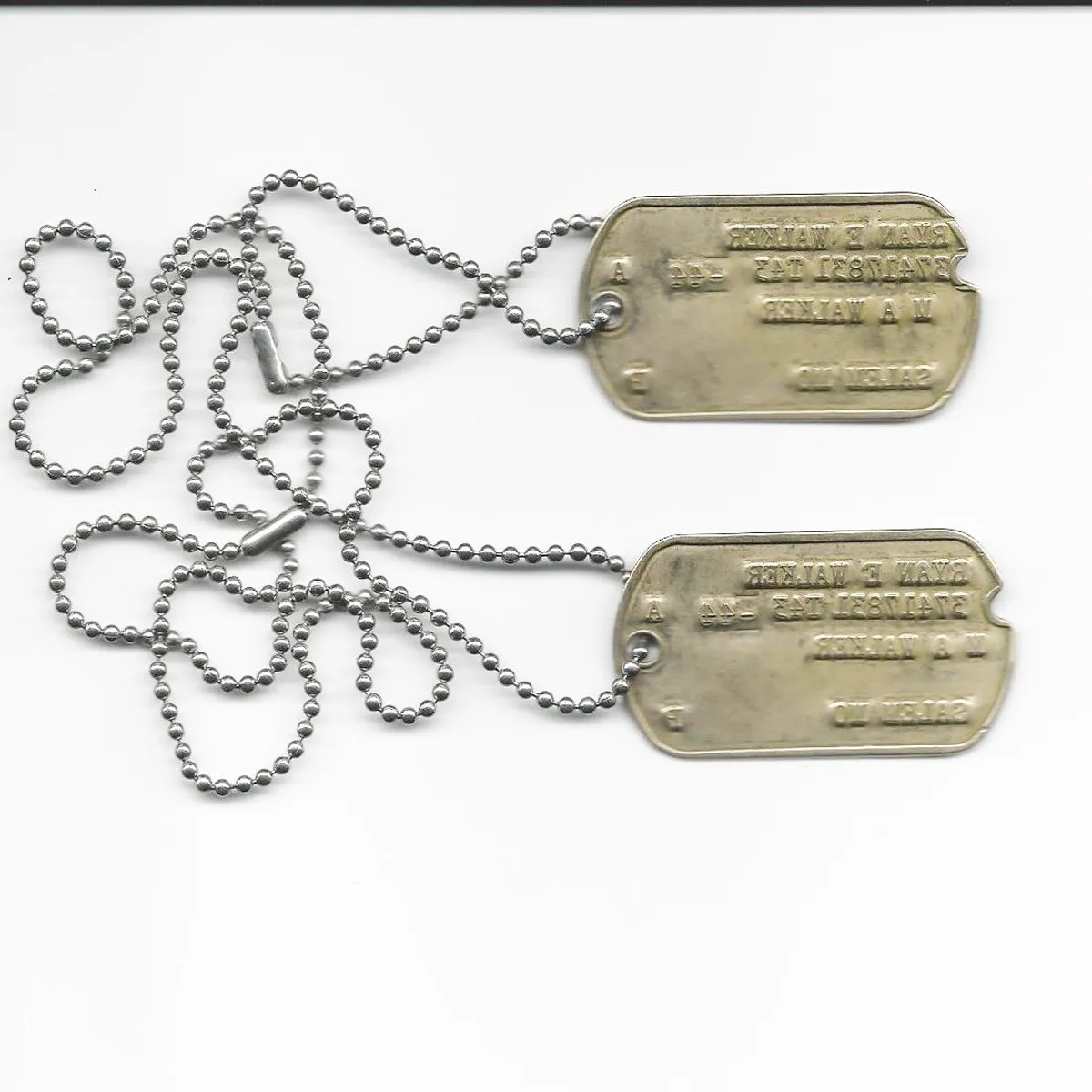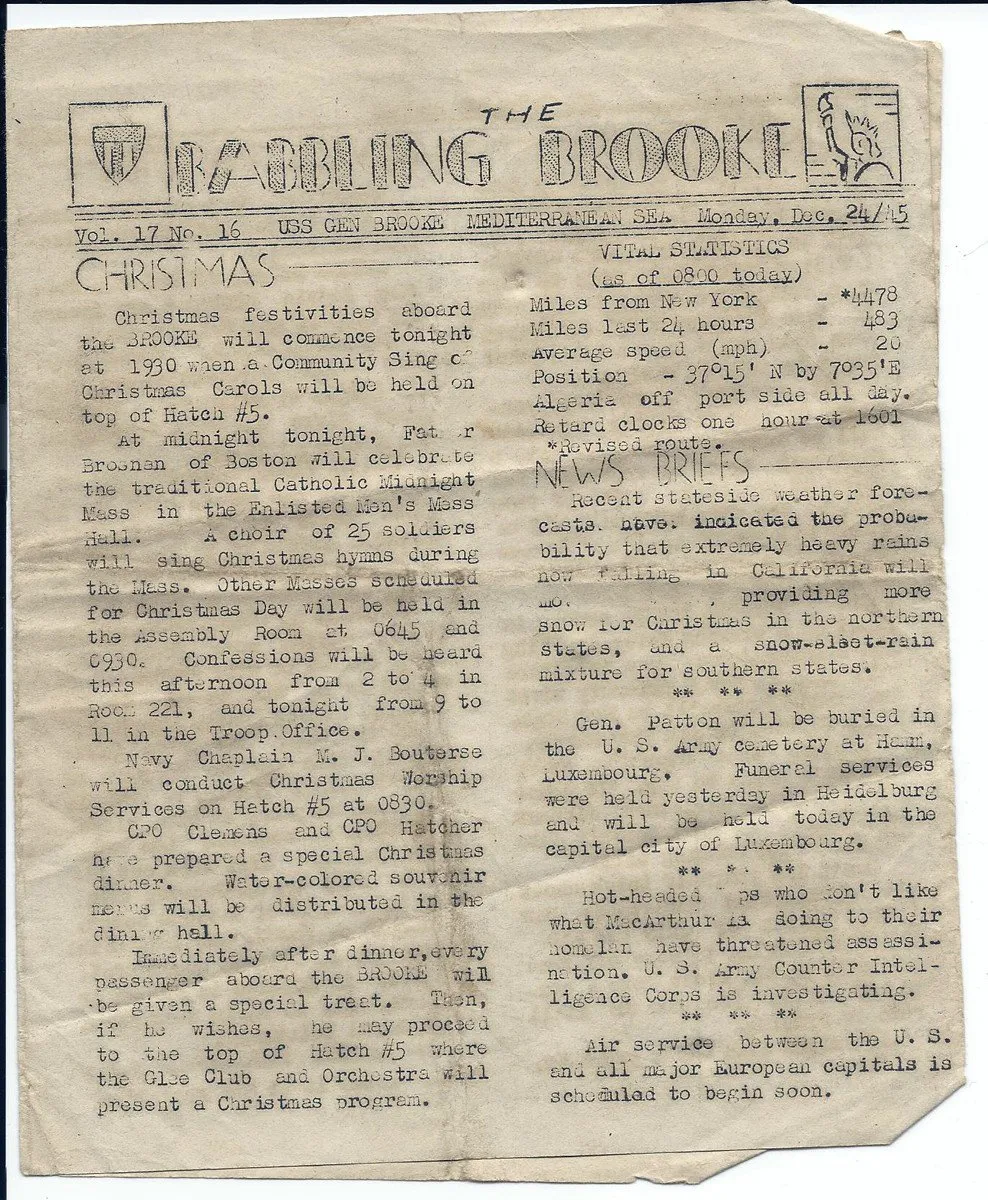Original Items: one-of-a-kind set. Literally this comes "straight out of the attic! This grouping belonged to RYAN E. WALKER, #57417831 T43 from Salem Missouri. What this German fiber trunk with German Maker's name includes is the following:
Corporal Ryan Walkers 1942 dated tunic with his initials and number (R.E.W. 7831) complete with all buttons, insignias, badges including his post WW2 Veterans of Foreign Wars shoulder patch. Much information including the 1942 date to be found in the original government tag in the internal right breast pocket.
Matching trousers also marked with his initials and serial number
Garrison Cap marked MISSOURI and 2661 with Veterans of Foreign Wars woven hat badge.
Khaki shirt with his name pinned in the rear together with his tie, also named.
1944 dated N.C.O. CLUB CARD to the TOPEKA ARMY AIRFIELD branch valid for OCTOBER 1943.
Victory I.D. Card in Russian and English
Dog Tags complete with chain.
Best of all is an original WW2 8" x 10" photograph of the entire ten crewmen of Corporal Walker's B-24 Liberator which is shown in the background. Every crewman is identified by both name and his position on the plane.
21 copies of an Army newspaper entitled "The Babbling Brooke" all dated to late 1945.
Christmas Song Sheet from the American Red Cross from 1944.
This is a wonderful grouping from a tail gunner on a B-24 bomber in WW2.
The Consolidated B-24 Liberator was an American heavy bomber, designed by Consolidated Aircraft of San Diego, California. It was known within the company as the Model 32, and a small number of early models were sold under the name LB-30, for Land Bomber. The B-24 was used in World War II by several Allied air forces and navies, and by every branch of the American armed forces during the war, attaining a distinguished war record with its operations in the Western European, Pacific, Mediterranean, and China-Burma-India Theaters.
Often compared with the better-known Boeing B-17 Flying Fortress, the B-24 was a more modern design with a higher top speed, greater range, and a heavier bomb load; it was also more difficult to fly, with heavy control forces and poor formation-flying characteristics. Popular opinion among aircrews and general staffs tended to favor the B-17's rugged qualities and especially its higher operational ceiling above all other considerations in the European Theater. The placement of the B-24's fuel tanks throughout the upper fuselage and its lightweight construction, designed to increase range and optimize assembly line production, made the aircraft vulnerable to battle damage.[5] The B-24 was notorious among American aircrews for its tendency to catch fire. Its high fuselage-mounted "Davis wing" also meant it was dangerous to ditch or belly land, since the fuselage tended to break apart. Nevertheless, the B-24 provided excellent service in a variety of roles thanks to its large payload and long range and was the only bomber to operationally deploy the United States' first forerunner to precision-guided munitions during the war, the 1,000 lb. Azon guided bomb.
The B-24's most costly mission was the low-level strike against the Ploiesti oil fields, in Romania on 1 August 1943, which turned into a disaster because the defense was underestimated and fully alerted while the attackers were disorganized.
The B-24 ended World War II as the most produced heavy bomber in history. At over 18,400 units, half by Ford Motor Company, it still holds the distinction as the most-produced American military aircraft.
Introduction to service, 194142
The United States Army Air Forces (USAAF) took delivery of its first B-24As in mid-1941. The USAAF initially used the type as transports. The sole B-24 in Hawaii was destroyed by the Japanese attack on Pearl Harbor on 7 December 1941.
The first USAAF Liberators to carry out combat missions were 12 repossessed LB-30s deployed to Java with the 11th Bombardment Squadron (7th Bombardment Group) that flew their first combat mission in mid-January. Two were shot up by Japanese fighters, but both managed to land safely. One was written off due to battle damage and the other crash-landed on a beach.
US-based B-24s entered combat service in 1942 when on 6 June, four B-24s from Hawaii staging through Midway Island attempted an attack on Wake Island, but were unable to find it.[23]
Strategic bombing, 194245
On 12 June 1942, 13 B-24s flying from Egypt attacked the Axis-controlled oil fields and refineries around Ploiesti, Romania.
Over the next three years, B-24 squadrons deployed to all theaters of the war: African, European, China-Burma-India, the Battle of the Atlantic, the Southwest Pacific Theater and the Pacific Theater. In the Pacific, the B-24 (and its twin, the U.S. Navy PB4Y Privateer) was eventually designated as the standard heavy bomber to simplify logistics and to take advantage of their longer range, replacing the shorter-range B-17 which had served early in the war along the perimeter of the Pacific from the Philippines, Australia, Espiritu Santo, Guadalcanal, Hawaii, and during the Battle of Midway from Midway Island.
While pilots who flew both preferred the B-17, the B-24 was faster, had longer range, and could carry a ton more bombs. It was one of the workhorse bombers of the U.S. Eighth Air Force in the Combined Bomber Offensive against Germany, forming about one-third of its heavy bomber strength, with the other two-thirds being B-17s. Thousands of B-24s, flying from bases in England, dropped hundreds of thousands of tons of high explosive and incendiary bombs on German military and industrial targets. The 44th Bombardment Group was one of the first two heavy bombardment groups flying the B-24 with the 8th Air Force in the fall/winter air campaigns in the European Theater of Operations. The 44th Bomb Group flew the first of its 344 combat missions against the Axis powers in World War II on 7 November 1942.
B-24s of the Ninth Air Force, operating from Africa and Italy, and the Fifteenth Air Force, also operating from Italy, took a major role in strategic bombing. Fifteen of the 15th AF's 21 bombardment groups flew B-24s. The Ninth Air Force moved to England in 1944 to become a tactical air force, and all of its B-24s were transferred to other Air Forces, such as the Fifteenth Air Force in Italy.
The first B-24 loss over German territory occurred on 26 February 1943. Earlier in the war, both the German Luftwaffe and the British Royal Air Force had abandoned daylight bombing raids because neither could sustain the losses suffered. The Americans persisted, however, at great cost in men and aircraft. In the period between 7 November 1942 and 8 March 1943, the 44th Bomb Group lost 13 of its original 27 B-24s.[15] For some time, newspapers had been requesting permission for a reporter to go on one of the missions. Robert B. Post and five other reporters of The New York Times were granted permission. Post was the only reporter assigned to a B-24-equipped group, the 44th Bomb Group. He flew in B-24 41-23777 ("Maisey") on Mission No. 37 to Bremen, Germany. Intercepted just short of the target, the B-24 came under attack from JG 1's Messerschmitt Bf 109s. Leutnant Heinz Knoke (who finished the war with 31 kills) shot down the Liberator. Post and all but two of the 11 men aboard were killed. Knoke reported: "The fire spread out along the right wing. The inboard propeller windmilled to a stop. And then, suddenly, the whole wing broke off. At an altitude of 900 metres there was a tremendous explosion. The bomber had disintegrated. The blazing wreckage landed just outside Bad Zwischenahn airfield," which would later be used for some of the first Messerschmitt Me 163B Komet rocket fighter operations.
A total of 177 B-24s carried out the famous second attack on Ploesti (Operation Tidal Wave) on 1 August 1943, flying from their bases in northwestern Libya. In late June 1943, the three B-24 Liberator groups of the 8th Air Force were sent to North Africa on temporary duty with the 9th Air Force. The 44th Bomb Group was joined by the 93rd and the 389th Bomb Groups. These three units joined the two 9th Air Force B-24 Liberator groups for the 1 August 1943 low-level attack on the German-held Romanian oil complex at Ploesti. This daring assault by high altitude bombers at tree top level was a costly success. The 44th destroyed both of its assigned targets, but lost 11 of its 37 bombers and their crews. Colonel Leon W. Johnson, the 44th's commander, was awarded the Medal of Honor for his leadership, as was Col. John Riley "Killer" Kane, commander of the 98th Bomb Group. Kane and Johnson survived the mission but three other recipients of the Medal of Honor for their actions in the missionLt. Lloyd H. Hughes, Maj. John L. Jerstad and Col. Addison E. Bakerwere killed in action. For its actions on the Ploe?ti mission, the 44th was awarded its second Distinguished Unit Citation. Of the 177 B-24s that were dispatched on this operation, 54 were lost.




